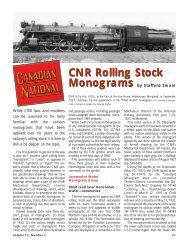CN LINES V12N3 - Canadian National Railways Historical Association
CN LINES V12N3 - Canadian National Railways Historical Association
CN LINES V12N3 - Canadian National Railways Historical Association
Create successful ePaper yourself
Turn your PDF publications into a flip-book with our unique Google optimized e-Paper software.
major change was the downward extension<br />
of the smokebox cover to merge with a<br />
smoothed pilot, all the while with Dr.<br />
Green computing improved resistance and<br />
observing air flow over the models at various<br />
wind speeds. The final U-4-a design<br />
was emerging, along with a decision to<br />
leave the Vanderbilt tenders unshrouded—<br />
the object of the exercise being, after all,<br />
the improvement of air flow over the boiler<br />
and cab.<br />
The <strong>CN</strong>R acted on Dr. Green’s data,<br />
which had received trade exposure in a<br />
May 1933 Railway Age article, by placing<br />
two orders for a total of eleven streamlined<br />
Northerns. Five were built by MLW<br />
in 1936 as <strong>CN</strong>R class U-4-a (Nos. 6400-<br />
6404), and six nearly identical engines<br />
were built by Ohio’s Lima Locomotive<br />
Works in 1938 for the Grand Trunk<br />
Western. GTW Nos. 6405-6410 were<br />
classed as U-4-b, and differed from their<br />
elder cousins most obviously in the design<br />
of the skyline casings’ grilled forward end.<br />
The <strong>CN</strong>R engines’ blunt, horizontally<br />
grilled opening contrasted with a concave,<br />
vertically slotted arrangement on the<br />
GTW engines. With its hint of a centred<br />
fin sweeping up from the headlight into<br />
the grille (which itself resembled experimental<br />
smoke-lifting stack shrouds on<br />
several other GTW engines), the GTW<br />
engine’s front-end styling was arguably the<br />
more rakish of the two U-4 subclasses.<br />
The <strong>CN</strong>R promoted its newly arrived<br />
U-4-a’s as “indicative of the progress made<br />
by the <strong>Canadian</strong> <strong>National</strong> <strong>Railways</strong>” during<br />
the 100 years since July 21, 1836—the<br />
first run of the locomotive Dorchester on<br />
Canada’s first railway, the 16-mile Cham-<br />
above left: As delivered, and visible here on brand-new No. 6400 during public display<br />
at St. Catharines, Ont., on June 20, 1936, the green nose stripes originally terminated in a<br />
flourish just ahead of the running board steps.—Al Paterson Collection<br />
above: Subtle differences abounded between the <strong>CN</strong>R U-4-a’s and GTW U-4-b’s. Compare<br />
skyline casing grilles, spoked vs. solid pilot-truck wheels, nose handrail and horizontal pilot<br />
foothold position, class-light mounts, pilot-to-cylinder-skirt fairings, headlight bezels, and<br />
number plate position.—<strong>CN</strong>R 6400 (1936), <strong>CN</strong>R photo; Shaun Arthur Collection. GTW No. 6407 (October<br />
1956), Al Paterson Collection<br />
below: Note the opening in the top of the skyline casing behind GTW No. 6405’s stack,<br />
through which air ingested by the front-end grille was vented to lift exhaust. This was the last<br />
GTW U-4-b to see service, in the autumn of 1959.—Al Paterson Collection<br />
plain & St. Lawrence in Quebec. During<br />
“a century of service,” the C&StL had<br />
become part of the <strong>CN</strong>R system, and railway<br />
publicists of 1936 thrilled readers<br />
with comparisons between the two locomotives.<br />
The 330-ton, 95-foot-long No.<br />
6400 was contrasted with “its remote parent,”<br />
the 16-ton Dorchester and its 85-foot<br />
train: “Thus, this mammoth of the steel<br />
highway was in itself longer than the<br />
entire pioneer train of 100 years ago.”<br />
Almost invisible amid the debut of the<br />
U-4-a’s were five unstreamlined U-2-d<br />
Northerns, Nos. 6160-6164, delivered by<br />
MLW in April 1936. Apart from the<br />
eleven U-4-a and U-4-b engines, and five<br />
S-4-b Mikados (Nos. 3801-3805) built at<br />
Kingston in 1936, these would be the<br />
only eight-coupled road power built for<br />
the <strong>CN</strong>R system between 1930 and 1940.<br />
The U-4-a’s weighed 236,000 pounds<br />
on their 77-inch drivers, with a total<br />
Volume 12, Number 3 13



